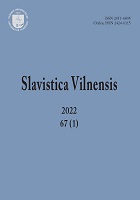Spoon, Knife and Fork across Slovenian Dialects
Spoon, Knife and Fork across Slovenian Dialects
Author(s): Januška Gostenčnik, Mojca Kumin HorvatSubject(s): Comparative Linguistics, Sociolinguistics, South Slavic Languages
Published by: Vilniaus Universiteto Leidykla
Keywords: Slovenian dialects; Slovenian linguistic atlas; cutlery; word-formation; geolinguistics; comparative Slavic linguistics;
Summary/Abstract: The article presents Slovenian dialect names for cutlery used in eating or preparing food – spoon, knife and fork, from a geolinguistic, word-formational as well as etymological and semantic-motivational perspective. The ethnological framework serves in particular to present the reasons for the (non-)borrowing of lexemes. It turns out that the terms for spoon and knife are not diverse from the point of view of borrowing, since the denotata have been in use in the Slovenian language area for a relatively long time. The fork was introduced relatively late as part of cutlery, so the most common name for it is a word-formational diminutive, and a high level of lexeme borrowing is observed in contact with the non-Slavic language area. The name for knife demonstrates word-formational diversity due to different uses in the past. The lexemes nožič, vilice and razsoška or plural razsoške have undergone a word-formational change, as they have kept their structural suffixes, but these do not (or rather, no longer) carry word-formational meaning; they are thus tautological derivations. The lexemes nož and pošada display a semantic change, as the meaning of both has narrowed in the hypernym → hyponym direction.
Journal: Slavistica Vilnensis
- Issue Year: 67/2022
- Issue No: 1
- Page Range: 99-115
- Page Count: 17
- Language: English

